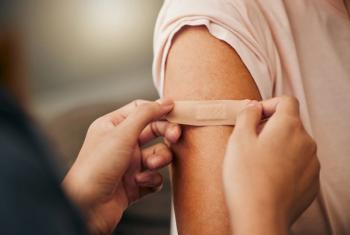
It's a jungle out there: Help keep your patients safe from outdoor animal and weather hazards!
Playing outside is a long-held joy of childhood, but bugs and animals that can cause harm lurk in places where children are likely to be playing?including the lawn, the woods, and the playground. Dennis L. Murray, MD, professor of pediatrics at the Medical College of Georgia in Augusta, offered preventive advice that you can share with parents during a seminar, "Keeping Children Safe in the Great Outdoors" Saturday at the 2006 AAP National Conference and Exhibition in Atlanta.
Playing outside is a long-held joy of childhood, but bugs and animals that can cause harm lurk in places where children are likely to be playing - including the lawn, the woods, and the playground. Dennis L. Murray, MD, professor of pediatrics at the Medical College of Georgia in Augusta, offered preventive advice that you can share with parents during a seminar, "Keeping Children Safe in the Great Outdoors" Saturday at the 2006 AAP National Conference and Exhibition in Atlanta.
It's estimated that 4.5 million dog bites and 400,000 cat bites occur in the United States annually. Although the risk of rabies is not high, other infections can develop in the wound from a bite. For patients who are brought to you with a mild injury from a dog or cat bite, a prophylactic antibiotic probably isn't necessary. Prophylaxis for more serious bites, within eight to 12 hours of injury, and given within two or three days after the child was bitten may, however, decrease the rate of infection. Amoxicillin is the preferred treatment. For more serious cases involving hospitalization, IV ampillin-sulbactam is preferred. Treatment should last for seven to 10 days for skin/soft tissue, and at least three to four weeks for a bone infection.
Mosquitoes and ticks also lurk in places where children are likely to play, so parents need to make sure their child is properly protected, said Dr. Murray. The best preventive strategy against tickborne infection, such as Lyme disease, ehrlichiosis, and Rocky Mountain spotted fever, involves avoidance of tick-infested habitats whenever possible; using personal protection, such as covering arms and legs with clothing; using a tick repellent that contains DEET (but not for the very young); inspecting the skin after spending time outside; prompt and proper removal of ticks (using forceps or tweezers); and limiting the length of time the tick remains attached.
Dr. Murray urges parents to eliminate pools of standing water, such as fountains and ponds, when possible because mosquitoes that can spread West Nile virus infection and other diseases breed in standing water. They should also limit their child's outdoor activities at peak mosquito periods - that is, dawn and dusk - and cover arms and legs with clothing and use repellent.
Dee Hodge III, MD, of the division of emergency medicine in the department of pediatrics at Washington University School of Medicine, St. Louis Children's Hospital, followed with more advice on keeping children safe outdoors. When a child presents with hypothermia, Dr. Hodge advised, handle the patient gently, rapidly assess airway and breathing, monitor cardiac rhythm, obtain a core temperature by rectal thermometer, and classify the degree of hypothermia (mild, moderate, severe, or profound).
General frostbite, which occurs when ice crystals form within tissues, is sometimes seen with children who participate in winter sports such as ice hockey, skiing, and outdoor skating. It commonly involves the lower extremities, hands, ears, and tip of the nose. Frostbite presents with a painful cold feeling and skin blanching followed by numbness. The best management plan, Dr. Hodge says, is analgesia, rapid thawing of the frozen extremities, and total immersion in a circulating large tub or whirlpool heated to about 104° F. You should protect the wounds from infection with sterile dry dressings, leave blebs intact but debribe them if ruptured, obtain a plastic surgery consult early, and admit the patient for one or two days.
At the opposite spectrum, children can also be affected by extreme heat. Heat excess syndromes include heat cramps, heat exhaustion, and heat stroke. To treat heat cramps, place the patient at rest in a cool environment and replace lost salt with a salt- containing oral rehydration solution. For heat exhaustion, assess airway and breathing and administer oxygen, monitor vital signs, and measure rectal temperature with a hyperthermic thermometer. For heat stroke - the most serious of heat excess syndromes - treat seizures with lorazepam or diazepam and admit the child immediately for care in a pediatric intensive care unit.
Newsletter
Access practical, evidence-based guidance to support better care for our youngest patients. Join our email list for the latest clinical updates.











